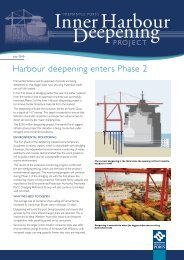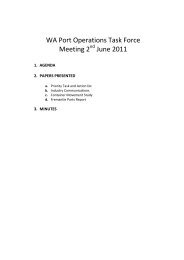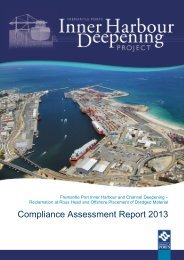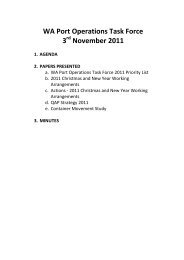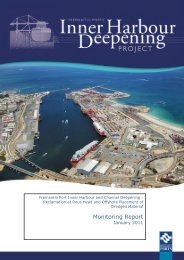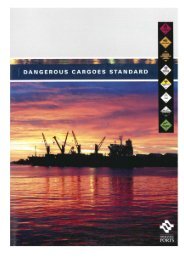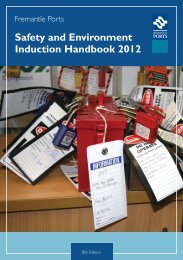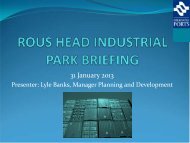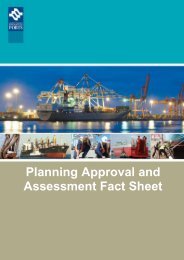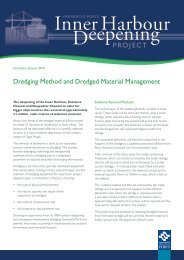Fremantle Port Inner Harbour and Channel ... - Fremantle Ports
Fremantle Port Inner Harbour and Channel ... - Fremantle Ports
Fremantle Port Inner Harbour and Channel ... - Fremantle Ports
Create successful ePaper yourself
Turn your PDF publications into a flip-book with our unique Google optimized e-Paper software.
3. Monitoring Sites<br />
3.1. Water Quality Overlying Seagrass <strong>and</strong> Coral<br />
Sites to monitor water quality overlying seagrass <strong>and</strong> coral have been located in BPPH<br />
management zones in each of five regions, as well as at reference sites (Figure 3.1). These<br />
regions are:<br />
• The Deep Water <strong>Channel</strong>;<br />
• The Offshore Disposal Area;<br />
• Rous Head <strong>and</strong> north of the <strong>Harbour</strong> Entrance;<br />
• South of the <strong>Harbour</strong> Entrance; <strong>and</strong><br />
• Hall Bank corals.<br />
As described in the DSDMP (<strong>Fremantle</strong> <strong>Port</strong>s, 2009), the monitoring site locations are based<br />
on BPPH management zones defined by modelling of seagrass <strong>and</strong> coral minimum light<br />
requirements. The management zones shown in Figure 3.1 are:<br />
• Zone of Loss (ZoL - < 30% minimum light requirement);<br />
• Zone of Effect (ZoE - 30 to 100% minimum light requirement); <strong>and</strong><br />
• Zone of Influence (ZoI – total suspended solids (TSS) – 2 mg/L above background for<br />
any 3 hour duration throughout the dredging period).<br />
The locations of water quality monitoring sites overlying seagrass shown in Figure 3.1 are<br />
based on habitat mapping that was ground-truthed in December 2009 (Oceanica,<br />
unpublished), as per the matrix of regions vs. management zones shown in Table 3.1 (<strong>and</strong><br />
rationale described in the DSDMP).<br />
The locations of water quality monitoring sites overlying corals shown in Figure 3.1 are at the<br />
northern <strong>and</strong> western sections of Hall Bank. The two sites overlie coral communities of similar<br />
benthic cover, species composition <strong>and</strong> depth distribution. There are no known reference<br />
sites for Hall Bank corals in the Perth metropolitan region.<br />
Table 3.1<br />
Matrix of BPPH management zones vs. seagrass <strong>and</strong> coral monitoring sites<br />
Region Zone of Loss Zone of Effect<br />
Zone of<br />
Influence<br />
Reference Total<br />
Seagrass Sites<br />
Deep Water<br />
<strong>Channel</strong><br />
- 2 sites 2 sites 2 sites 6<br />
Offshore<br />
Disposal Area<br />
- 2 sites 2 sites 2 sites 6<br />
Rous Head <strong>and</strong><br />
north of the<br />
<strong>Harbour</strong><br />
2 sites 2 sites 2 sites 2 sites* 8<br />
Entrance<br />
South of the<br />
<strong>Harbour</strong><br />
- 2 sites 2 sites 2 sites* 6<br />
Entrance<br />
Total 26<br />
Coral Sites<br />
Hall Bank Corals - - 2 sites - 2<br />
Total 2<br />
* Note that these reference sites as shown in Figure 3.1 are within the Zone of Influence; however, it is not<br />
anticipated that these sites will be impacted by the dredge plume. In the unlikely event that one of these<br />
reference sites shows any influence from dredging (e.g. via aerial observations <strong>and</strong> comparison to other<br />
reference sites), then it shall be relocated.<br />
3.2. Return Water Plume<br />
Water samples will be taken at six monitoring sites along a plume transect at increasing<br />
distance from the return water outlet / weir box, with an example shown in Figure 3.1 <strong>and</strong><br />
Figure 3.2. The transect will follow the approximate trajectory of the plume <strong>and</strong> therefore<br />
Oceanica: <strong>Fremantle</strong> <strong>Port</strong>s: <strong>Inner</strong> <strong>Harbour</strong> <strong>and</strong> <strong>Channel</strong> Deepening - Water Quality Monitoring Program 5



